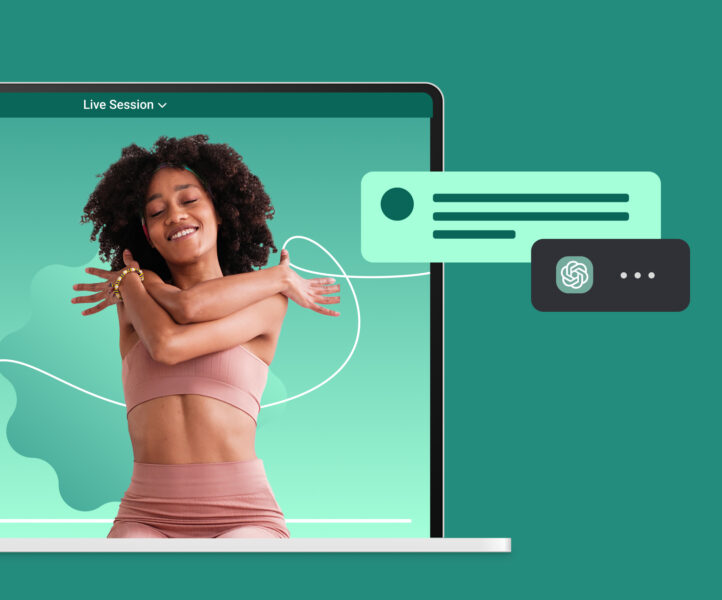As education technology develops at an ever-increasing rate, many educators are left wondering how to adapt to the new learning landscape. It’s exciting – but also unsettling for some.
The truth is, there are a huge range of benefits of technology in education – ranging from more collaboration to increased efficiency, and the chance to adapt content to different learning styles. Use education technology to reduce your costs, increase accessibility, and make your content more engaging for learners.
Here are the top 11 benefits of technology in education – plus examples of exactly how to use it for the best results.
Click the links below to skip ahead:
Top benefits of technology in education
- Boost collaboration
- Connect with learners
- Encourage continuous learning
- Create engaging content
- Adapt to different learning styles
- Improve accessibility and inclusion
- Use personalized learning paths
- Improve efficiency with automation
- Track learners’ progress
- Reduce running costs
- Work with technology – not against it
And to help you keep up with the changes and use them for the benefit of learners and educators, download our Ultimate Guide to Technology.
[xyy-ihs snippet=”platform-buyers-guide”]
Top benefits of technology in education
Here are the top 11 benefits of technology in education and how to make the most of the education technology around today.
The average person spends 2 hours and 31 minutes on social media every day – and for 16-24-year-olds that figure goes up to 5 hours 49 minutes.
The clue is in the name – social media is all about connecting with others, sharing, chatting, and learning collaboratively. One of the top benefits of technology in education is the impact it can have on communication and collaboration between learners.
If you can tap into the social elements of education technology, you can connect with your learners in a way that’s never been possible before. The use of technology in education opens up new avenues for social learning.
Use education technology to encourage social learning through a wide range of different methods, including:
- Live virtual classrooms for discussions
- Forums and message threads for Q&As
- Topic-specific Pinterest boards
- Themed Twitter or LinkedIn hashtags and threads
- Interactive quizzes and games
- Online leaderboards and rewards
Encourage your learners to connect with social learning activities to boost collaboration and social learning and improve outcomes across the board.
For educators, using technology in education is also an opportunity to build closer connections with your learners. Build a learning community to develop a direct link to your learners – increasing brand loyalty and opening up new opportunities for upselling and reconversions.
If you’re a Creator Educator, an online community is a top method to help your business grow long-term. An interactive online community lets learners engage and interact with your brand whenever they want, building trust and creating a culture of support and sharing.
In your community space, you can interact directly with learners, including:
- Hosting live Q&A sessions
- Setting office hours
- Discussing trending topics
- Setting group goals
- Celebrating learner milestones
Using technology to create your own learning community gives you total control over your audience interactions, so you can connect with and retain more customers and build your brand awareness.
To see how it’s done, check out this case study on how a therapist became a full-time educator by tapping into online communities to help learners and grow her business.
Rather than relying on traditional classroom learning, technology in education has created more opportunities for continuous learning – wherever and whenever your learners are.
That means learning can now take place on the subway, at the gym, and even in the bath thanks to education technology that delivers learning content in a range of different formats and styles – think podcasts, video, microlearning lessons, and quick quizzes.
Recent advances in education technology mean educators can now adapt their content to fit every learner’s needs and preferences. The best part? Educators and administrators simply upload the content to a platform like a Learning Management System (LMS) and either bulk publish or drip feed content to learners for them to access when they want it.
When it comes to continuous learning, the impact of technology in education can’t be overstated – educators now have access to a global audience of learners across any and all time zones. The only requirements learners need are a device and an internet connection.
Download our Ultimate Guide to Education technology to learn more:
[xyy-ihs snippet=”platform-buyers-guide”]
Education technology gives educators the chance to shake up the routine of regular learning. Drive learner curiosity and creativity by using technology to help students embrace their natural curiosity by creating discovery-driven content – like independent research, games, peer reviews and more.
Here are some examples of how to use education technology to encourage learner curiosity:
- Ask students to make their own videos and recorded presentations
- Set online research assignments
- Encourage peer-review and feedback sessions
- Set online creative games and science experiments
If you can build a culture of curiosity through your content, you can make the learning experience more engaging and dynamic – to boost course completion rates and increase knowledge retention.
Technology in education has also made it possible for educators to adapt their content to meet the specific needs of different learning styles.
Educators can now tailor their content to all of the 7 main learning styles, including:
- Visual learning: Visual learners learn best through demonstrations, reading directions, or seeing pictures, diagrams and charts. Use technology like YouTube videos, infographics, and animations to engage visual learners.
- Auditory learning: Preferring listening and speaking to reading, auditory learners can be encouraged to connect with learning content through podcasts, voice recordings, audiobooks, and text-to-speech tools.
- Kinesthetic learning: For learners who learn best with hands-on, interactive activities, educators can use education technology to encourage game-based learning and virtual or interactive experiences. Kinesthetic learners are also likely to enjoy Virtual Reality (VR) activities too.
- Verbal learning: For verbal learners, learning content that involves reading and writing text is most effective for knowledge retention. These learners can take advantage of online written resources like workbooks, articles, and speech-to-text tools.
- Logical learning: Logical or analytical learners prefer to use logic to process information, enjoying creating connections and looking for patterns in learning content. To engage logical learners, ask open-ended questions and include problem-solving activities in your content – think interactive class debates, individual research questions, and online Q&As.
- Social learning: As the name suggests, social learners love to learn through social interactions. Online learning can sometimes be isolating, so make sure to include social learning activities like group discussions, peer reviews, and class quizzes or games.
- Solitary learning: On the flip side, solitary learners prefer to learn solo – so include activities like journaling, solo projects, and single-player games to engage them.
Take advantage of education technology to engage and accommodate learners through the learning styles they prefer. For example, you can set multiple activities for each learning module and let your learners choose the activity they like best. Try to include a combination of solo, group, and hands-on tasks every time.
[xyy-ihs snippet=”platform-buyers-guide”]
One of the top benefits of technology in education is the improvements in accessibility and inclusion that have been made possible. As well as opening up opportunities to cater to multiple learning styles, educators can now make sure their content is accessible for all learners.
Tools like text-to-speech software, screen readers, braille displays and more have made it simpler and easier for students with visual impairments and dyslexia, for example, to access learning content.
Here are some more examples of accessible technology in education:
- Voice control software
- Subtitles and closed captions on videos
- Shortcut keys
- Speech-to-text software
- Phonetic spelling software
- Electronic worksheets
- Talking calculators
Learn more about Universal Design for Learning and accessibility here.
As well as boosting learner curiosity and making space for different learning styles, the rise of technology in education has also paved the way for unprecedented personalization.
For the first time, educators can offer personalized learning paths on a much bigger scale – accommodating a wider range of learners who can now learn at their own pace, and choose exactly what content to engage with.
Here are just a few of the ways education technology makes personalized learning possible:
- Self-paced, flexible learning: With access to technology in education, learners can progress through content at their own pace, fitting learning around their schedule and commitments, including family, work, and more. Rather than requiring learners to be present in the classroom at a certain time and location, learning is now possible anytime and anywhere. Learners can also choose the content and modules most relevant to them, rather than following a one-size-fits-all learning path.
- Personalization at scale: Personalized learning is all about learner-centered education, with content that’s shaped to every learner’s unique needs, interests, and preferences. This type of personalized learning is almost impossible to achieve at scale without the use of education technology – but now even more learners can benefit from customized, adaptable learning paths.
- Provide extra support: Some learners need more support than others and education technology gives educators the chance to identify and address learning gaps in real-time, including adapting content, providing individual feedback, and assigning human or AI-driven tutors to the learners who need it most.
[xyy-ihs snippet=”platform-buyers-guide”]
Enrollment, onboarding, assignments, and certificates – automating all of these processes is now possible thanks to the rise of technology in education.
For educators, a whole host of repetitive tasks can now be automated, giving you more time and energy to work on the parts of your business that need you most – like content creation, marketing, and more.
Don’t make learners wait for your content, use automatic rollout to release content as and when it’s needed – for example, when learners successfully complete assignments, they can automatically unlock the next learning module to allow them progress at their own pace.
Here are some more examples of everyday processes you can automate:
- Admissions
- Student registration
- Scheduling calls and classes
- Surveys and student feedback
- Attendance or course completion tracking
- Permission forms
- Audits and compliance
- Grading and student progression
Free up more time to focus on what matters most, while delivering a smoother and more seamless experience for your learners.
Technology in education has also enhanced the opportunity for educators to track learners’ progress in more detail – including course completion rates, drop-off rates, and learner performance.
For the first time, educators can now take a data-driven approach to learner performance. Get real-time insights as learners progress through your content, tracking how they engage with your content so you can offer extra support where it’s needed.
This is essential for improving safety and compliance across a range of industries. Organizations can now keep track of who has completed essential onboarding, training, and refreshers, flagging when learners need to update or add-to their current knowledge.
By utilizing technology in education, you also open up new areas of efficiency. Provide instant feedback – via video, interactive comments or a messenger app – based on the insights and data you receive from your LMS or learning platform. And adapt your content in real-time according to learners’ needs.
Stop making stabs in the dark and start taking a data-led approach to education for better results.
[xyy-ihs snippet=”platform-buyers-guide”]
Implementing technology in education is key for reducing costs for Creator Educators, educational institutions – and ultimately learners.
As well as helping educators save money, education technology can also lower the barrier to entry by helping rollout educational content that’s more affordable for more people.
Technology in education can reduce costs in a range of different ways, including:
- Using automation to reduce human hours spent on manual tasks
- Using virtual spaces to minimize the need physical classrooms
- Going paperless with online resources
- More low cost tools for creating content – including video, audio, and images
- Subscription services that are cheaper than learning same content at college
Education technology gives more learners the chance to gain new skills, explore topics they’re passionate about, and advance in their careers. Thanks to the opportunity to create education content at scale, it’s cheaper than ever to produce, publish, and engage with content.
While some educators have seen the rapid rise of technology in education as a negative – for those who are able to work with technology rather than against it, the benefits can be incredible.
With the introduction of AI-driven tools like ChatGPT, educators now have the chance to engage learners in new and innovative ways, encouraging healthy and productive relationships between learners and technology.
Here are a few ideas to help you do just that:
- Use AI tools to help students draft outlines for assignments
- Generate creative lesson plans
- Provide personalized feedback
While it’s now possible for students to ask AI tools to complete assignments for them, it’s also possible for educators to set increasingly creative and fun activities using those same tools.
Take advantage of these top benefits of technology in education
The truth is technology in education isn’t going anywhere – so it’s time to take advantage of the top benefits to create a more engaging, personalized, and continuous learning experience. Use technology in education to make your life easier too – by automating key tasks and tracking your learners’ progress, while building closer connections with each cohort.
[xyy-ihs snippet=”platform-buyers-guide”]
This post was originally published in July 2023. It was updated in August of 2023 with more information.






